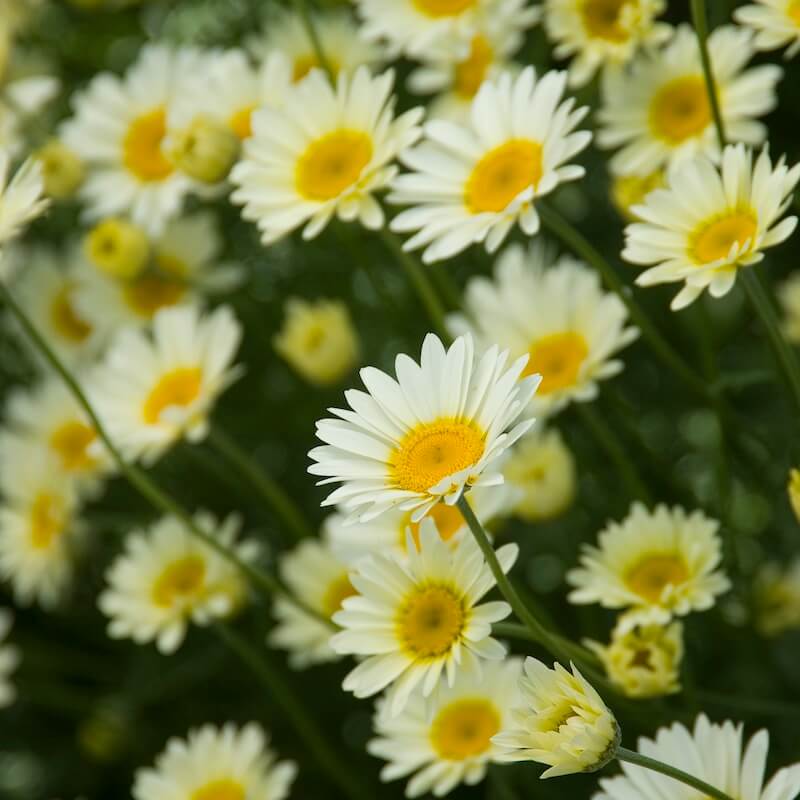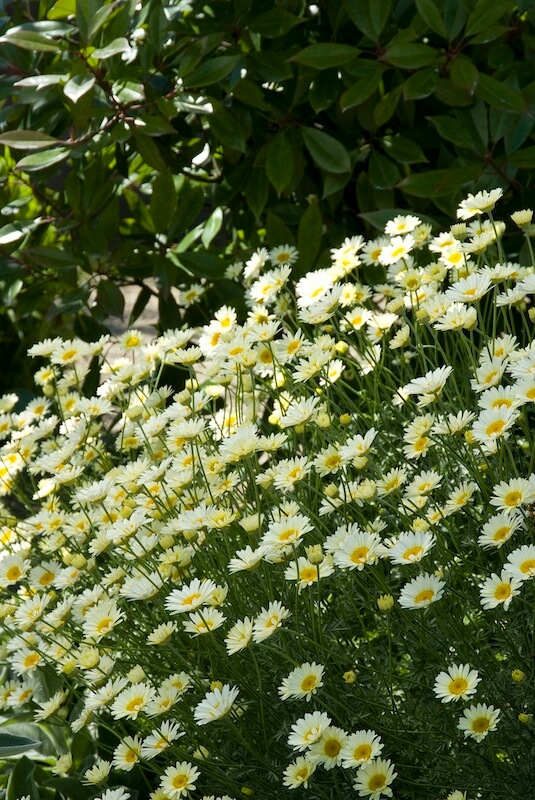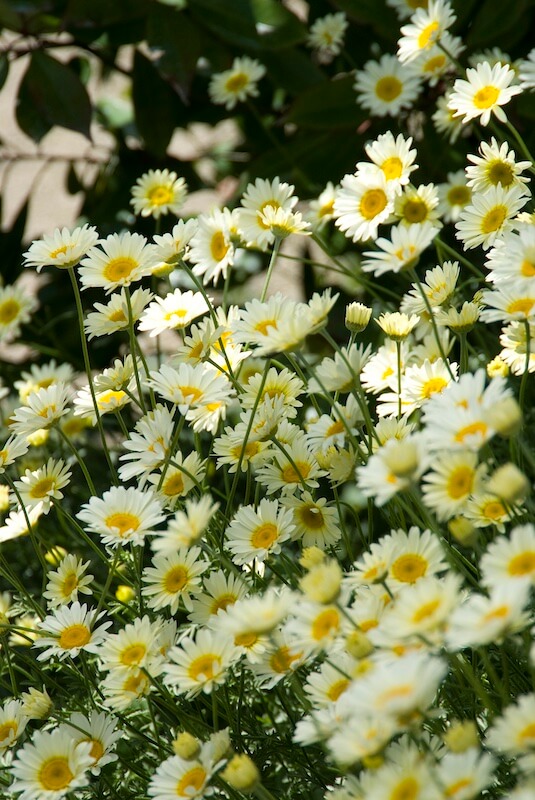Anthemis Sauce Hollandaise - A Long-Flowering Gem for Sunny Borders
Dyer’s Chamomile Sauce Hollandaise, Cota tinctoria Sauce Hollandaise, Anthemis tinctoria Sauce Hollandaise

Position
- Prefers a position in full sun for the best flowering and compact habit
- Excellent for borders, gravel gardens, wildlife gardens, and cottage-style plantings
- Tolerates exposed and coastal sites well
Hardiness
- Hardy down to around –15°C (5°F)
- Reliable throughout most of the UK, even during typical winters
Soil
- Thrives in well-drained, moderately fertile soil
- Performs well on sandy or stony soils and also copes with poorer ground if improved
- Avoids heavy clay or waterlogged areas, especially in winter
- Tolerates acid, neutral, or alkaline soils
- Very adaptable, provided drainage is good
- Grab a soil test kit and ensure the perfect conditions for growth
Height
- Usually reaches 40–60 cm (16–24 inches) after 5–10 years
- Forms a bushy, upright, semi-evergreen perennial with finely divided, grey-green leaves
Seasons of Interest
- Foliage: Attractive, finely cut, grey-green foliage from spring to autumn
- Autumn Colour/Variegation: No notable autumn colour or variegation; foliage remains semi-evergreen in mild winters
- Flowering: Masses of large, creamy-yellow, daisy-like flowers from early June to September
- Flowers are loved by bees, butterflies, and other pollinators
Additional Notes
- Deadhead regularly to extend flowering time and encourage more blooms
- Mulch in spring with compost to support growth and retain some moisture, but ensure good drainage at the base
- Drought-tolerant once established, requiring little extra watering
- Cut back hard after flowering or in early spring to maintain neatness
- Low maintenance and generally free from serious pests or diseases
- May be grown in containers with good drainage and regular watering in summer
Anthemis Sauce Hollandaise - Perfect for Pollinators and Dry Spots
Anthemis Sauce Hollandaise is a cheerful perennial plant that brings a fresh splash of soft yellow daisies to any garden. Also known as dyer’s chamomile, this delightful marguerite variety stands out for its creamy yellow flowers and feathery green foliage. If you’re looking for a hardy, drought-tolerant plant that thrives in full sun and adds lasting colour through the summer, this is an excellent choice.
What is Anthemis tinctoria and Why Choose ‘Sauce Hollandaise’?
Anthemis tinctoria, commonly called dyer’s chamomile, is a perennial plant native to Europe and western Asia. It is celebrated for its bright, yellow daisy-like flowers and finely divided green foliage that create an airy, mounding form. The ‘Sauce Hollandaise’ cultivar stands apart with its creamy yellow petals and darker yellow centres, offering a subtle but eye-catching colour contrast.
This plant typically grows to around 60 cm in height and produces an abundance of flowers from late spring to late summer. Its long flowering season and drought tolerance make it a reliable addition to sunny borders or containers. Garden enthusiasts value it for both its ornamental appeal and its ability to attract pollinators, such as bees.
How Does Anthemis Sauce Hollandaise Grow in Your Garden?
Anthemis Sauce Hollandaise thrives best in well-drained, fertile soil under full sun. It prefers a sunny spot where its soft yellow flowers can truly shine. The plant forms a neat, bushy mound with feathery green foliage that complements its flower spikes beautifully.
You can grow it in borders, pots, or even as a low-maintenance ground cover. It tolerates dry soil once established, making it ideal for gardens that experience occasional drought. During the growing season, it produces a mass of daisy-like blooms that appear above the foliage, creating an attractive, vibrant display

What Makes Anthemis Sauce Hollandaise a Great Perennial?
One of the key benefits of Anthemis tinctoria Sauce Hollandaise is its long-lasting colour. Unlike some perennials that fade quickly, this plant’s creamy yellow flowers brighten your garden throughout summer and into early autumn. The petals fade gradually, offering a natural, soft look rather than a sudden drop in colour.
This perennial dies back in winter but returns vigorously each spring. Its finely divided, aromatic leaves add texture and scent to the garden even when the flowers are not in bloom. The plant’s overall shape is tidy, which means it rarely requires staking or special care.
Can Anthemis Sauce Hollandaise Grow in Pots or Containers?
Absolutely! This plant adapts well to containers, making it a versatile choice for patios or balconies. In pots, Anthemis Sauce Hollandaise forms a compact mound that can brighten small spaces with its sunshine yellow flowers.
Choose a pot with good drainage and fill it with fertile, well-drained compost. Regular watering is essential for container-grown plants, especially during hot weather. Adding a slow-release fertiliser in spring can also boost flowering. With the right care, you can enjoy its cheerful blooms even in limited spaces.
What Plants Complement Anthemis Sauce Hollandaise in the Garden?
Pairing ‘Sauce Hollandaise’ with other perennials and shrubs creates a colourful, textural contrast in your garden. Ornamental grasses with their feathery plumes highlight the finely divided foliage of Anthemis tinctoria beautifully. Purple or grey-leaved plants, such as sage, also work well, providing a cool contrast to the creamy yellow flowers.
You can combine it with late summer bloomers to extend colour in your border. Plants like Buxton or other perennial sages help create a harmonious planting scheme. The key is to place ‘Sauce Hollandaise’ in an area that receives full sun and dry conditions, which suit it best.
How Does Anthemis Sauce Hollandaise Attract Bees and Other Insects?
This plant is excellent for supporting pollinators. The soft yellow daisies produce nectar that attracts bees throughout the flowering season. Its open, daisy-like flowers are easy for insects to access, making it a favourite in wildlife-friendly gardens.
Encouraging bees with plants like Anthemis tinctoria supports biodiversity and helps other plants in your garden flourish. Adding a mix of insect-friendly perennials creates a lively, vibrant garden full of activity and colour.
Can You Grow Anthemis tinctoria from Seed?
Yes, growing Anthemis tinctoria from seed is a rewarding way to add this perennial to your garden. Seeds can be sown indoors in early spring or outdoors in a sunny, sheltered spot. Germination typically occurs within two to three weeks at temperatures between 15 °C and 20°C (59°F and 68°F).
Starting seeds in pots or trays allows you to control the soil and moisture easily. Once seedlings develop a few true leaves, they can be transplanted into the garden or larger pots. Growing from seed takes patience but offers a satisfying experience for keen gardeners.
How Should You Manage Anthemis Sauce Hollandaise Through the Seasons?
This plant has a predictable seasonal cycle that is easy to manage. In late spring to early summer, it produces its first flowers, continuing to bloom throughout summer. Regular deadheading helps maintain continuous flowering and prevents the plant from sprawling.
By late autumn, the flowers fade, and the plant naturally begins to die back. Cutting it down to ground level before winter helps tidy the garden and prepares it for new growth in spring. The green, feathery foliage also adds some garden interest throughout the growing season, even when flowers are scarce.
Where Can You Buy Anthemis Sauce Hollandaise for Your Garden?
You can find Anthemis Sauce Hollandaise at many garden centres and nurseries, especially during spring and early summer. Buying from a reputable nursery ensures you get healthy plants with strong root systems.
When selecting your plant, look for bright green foliage and an abundance of flower buds. Established plants will produce a mass of soft yellow daisies and are less likely to suffer from transplant shock. Buying early allows you to enjoy its cheerful blooms throughout the summer.
From Darren’s Patch
While I’m not currently growing Sauce Hollandaise in my garden, it’s one I recommend if you’re after reliable summer colour with very little fuss. Its creamy yellow daisies have a lovely softness that blends beautifully with grasses and silver-foliaged plants. I’ve seen it thrive in some tough spots — dry, sun-baked borders where other perennials struggle — and it just keeps flowering. It’s the sort of plant that quietly earns its place, especially in a naturalistic or pollinator-friendly scheme. If you’re after a perennial that punches above its weight in both performance and charm, this is one worth making room for.
![]()
Key Points to Remember
- Anthemis Sauce Hollandaise is a perennial with creamy yellow, daisy-like flowers that bloom from late spring to early autumn
- It grows best in full sun and well-drained, fertile soil, but tolerates dry and alkaline conditions once established
- The plant forms a neat, bushy mound with feathery green foliage, reaching about 60cm in height
- Regular deadheading promotes continuous blooming and maintains a tidy appearance
- It adapts well to both garden borders and pots, making it a versatile choice for many garden styles
- This perennial attracts bees and other pollinators, supporting a healthy garden ecosystem
- You can grow Anthemis tinctoria from seed or buy established plants from garden centres
- Cut back the foliage to ground level in late autumn to prepare for fresh growth in spring
- Pair ‘Sauce Hollandaise’ with ornamental grasses and plants like sage for attractive contrasts
By adding Anthemis Sauce Hollandaise to your garden, you invite a cheerful, easy-care perennial that brings sunshine yellow colour and supports local wildlife. Its long flowering season and attractive foliage make it a rewarding choice for gardeners looking to brighten their borders or containers.
Check out the RHS article here.
If you like this one, you’ll love Astrantia Roma. Click here to explore it
For more information on perennials for your garden, please click here.

Frequently Asked Questions
Q: What is Anthemis Sauce Hollandaise, and why is it popular in gardens?
A: Anthemis Sauce Hollandaise is a perennial plant, often known as dyer’s chamomile or marguerite, prized for its soft, creamy yellow daisy-like flowers. These pale yellow blooms appear from late spring through summer, creating a cheerful splash of colour in borders and pots. Its finely divided, feathery green foliage forms a neat mound around 60cm high. Valued for its drought tolerance and aromatic leaves, this plant thrives in well-drained, sunny spots and is perfect for mass planting or mixed borders.
Q: How should I grow and care for Anthemis tinctoria Sauce Hollandaise?
A: To grow Anthemis tinctoria Sauce Hollandaise successfully, choose a sunny spot with well-drained, fertile soil. This hardy perennial tolerates dry soil and benefits from light feeding in spring to promote healthy new growth. Regular deadheading encourages prolonged flowering throughout summer. After flowering, cut back the plant to ground level to maintain a tidy appearance and promote a fresh flush of foliage. Its aromatic, finely divided leaves add ornamental interest even when not in bloom.
Q: Is Anthemis tinctoria Sauce Hollandaise suitable as a cut flower?
A: Yes, Anthemis tinctoria Sauce Hollandaise produces excellent cut flowers. Its soft yellow daisies have sturdy stems, typically around 9cm in diameter, making them ideal for fresh floral arrangements. The flowers’ long-lasting nature and bright colour bring sunshine into interiors. Regular harvesting and deadheading in the garden not only extend the flowering period but also keep the plant healthy and attractive. This perennial is a favourite for gardeners seeking cheerful, drought-tolerant blooms for both garden display and indoor enjoyment.
Q: What are the best garden uses for Anthemis Sauce Hollandaise?
A: Anthemis Sauce Hollandaise works wonderfully in sunny borders, where its soft yellow flowers contrast beautifully against green foliage or darker-coloured plants such as purple sage. Its mounding habit complements ornamental grasses and herbaceous perennials, such as Buxton and other marguerites. The plant also performs well in pots and containers, ideal for brightening patios or terraces. Due to its drought tolerance and aromatic foliage, it suits low-maintenance gardens, adding vibrant colour and attracting pollinators like bees throughout summer.
Q: Where can I buy Anthemis Sauce Hollandaise?
A: You can purchase Anthemis Sauce Hollandaise from most well-stocked garden centres and specialist nurseries across the UK. It is also widely available through reputable online plant retailers. When purchasing, look for healthy plants with well-developed foliage and a generous number of buds to ensure robust growth. This perennial’s popularity means it is generally easy to source during the growing season. Buying from trusted suppliers guarantees your plant will thrive and add long-lasting, sunny charm to your garden.
